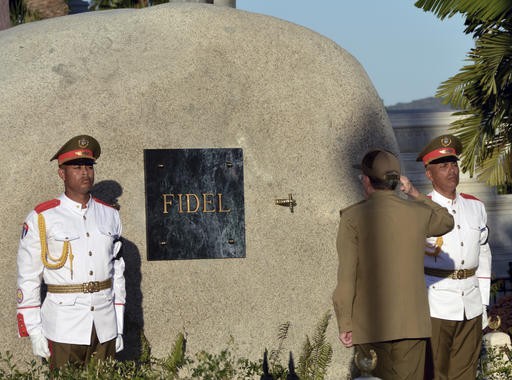Popular Reads
Top Results
Can't find what you're looking for?
View all search resultsPopular Reads
Top Results
Can't find what you're looking for?
View all search resultsFidel Castro laid to rest in private ceremony in east Cuba
Change text size
Gift Premium Articles
to Anyone
 Cuba's President Raul Castro salutes at the tomb of his older brother Fidel Castro, a simple, grey, round stone about 15 feet high, at the Santa Ifigenia cemetery in Santiago, Cuba, Sunday Dec.4, 2016. Raul Castro placed the ashes in a niche in the tomb that was then covered by a plaque bearing the single name, "Fidel." (ACN via AP/Marcelino Vazquez Hernandez/)
Cuba's President Raul Castro salutes at the tomb of his older brother Fidel Castro, a simple, grey, round stone about 15 feet high, at the Santa Ifigenia cemetery in Santiago, Cuba, Sunday Dec.4, 2016. Raul Castro placed the ashes in a niche in the tomb that was then covered by a plaque bearing the single name, "Fidel." (ACN via AP/Marcelino Vazquez Hernandez/)
A
wooden box containing Fidel Castro's ashes was placed by his brother and successor on Sunday into the side of a granite boulder that has become Cuba's only official monument to the charismatic bearded rebel who seized control of a US-allied Caribbean island and transformed it into a western outpost of Soviet-style communism that he ruled with absolute power for nearly a half century.
The private, early-morning ceremony was attended by members of Fidel Castro's family, the ruling Politburo of the single-party system he founded, and Latin American leaders who installed closely allied leftist governments in Venezuela, Bolivia, Nicaragua and Brazil.
After nine days of fervent national mourning and wall-to-wall homages to Castro on state-run media, the government barred independent coverage of the funeral, releasing a handful of photos and brief descriptions of the ceremony later in the day.
The ceremony began at 6:39 a.m. when the military caravan bearing Castro's remains in a flag-draped cedar coffin left the Plaza of the Revolution in the eastern city of Santiago. Thousands of people lined the two-mile route to Santa Ifigenia cemetery, waving Cuban flags and shouting "Long live Fidel!"
The ashes were delivered to Castro's younger brother and successor, President Raul Castro, who wore his olive general's uniform as he placed the remains into a niche in the enormous grey boulder that will serve as his tomb. The niche was sealed with a green marble plaque emblazed with the name "Fidel" in gold letters.
The tomb stands to the side of a memorial to the rebel soldiers killed in an attack that Castro led on Santiago's Moncada barracks on July 26, 1953, and in front of the mausoleum of Cuban national hero Jose Marti.
As the funeral ended, martial music could be heard outside the cemetery, where Ines de la Rosa was among the mourners gathered. She said she would have liked to watch the interment on television, but "we understand how they as a family also need a bit of privacy."
The decision to keep the final farewell private came the morning after Raul Castro announced that Cuba would prohibit the naming of streets and monuments after his brother, and bar the construction of statues of the former leader and revolutionary icon, in keeping with his desire to avoid a cult of personality.
"The leader of the revolution rejected any manifestation of a cult of personality and was consistent in that through the last hours of his life, insisting that, once dead, his name and likeness would never be used on institutions, streets, parks or other public sites, and that busts, statutes or other forms of tribute would never be erected," Raul Castro told a massive crowd gathered in the eastern city of Santiago.
He said that Cuba's National Assembly would vote in its next session on the law fulfilling the wishes of his brother, who died last week at 90. The legislature generally holds a meeting in December and under Cuba's single-party system, parliament unanimously or near-unanimously approves every government proposal.
Fidel Castro, who stepped down in 2006 after falling ill, kept his name off public sites during his near half-century in power because he said he wanted to avoid the development of a personality cult. In contrast, the images of his fellow revolutionary fighters Camilo Cienfuegos and Ernesto "Che" Guevara became common across Cuba in the decades since their deaths.
Mourning for Castro has been fervent and intense across the country since his death, particularly in rural eastern Cuba, where huge crowds have been shouting Castro's name and lining the roads to salute the funeral procession carrying his ashes.
"All of us would like to put Fidel's name on everything but in the end, Fidel is all of Cuba," said Juan Antonio Gonzalez, a 70-year-old retired economist. "It was a decision of Fidel's, not Raul's, and I think he has to be respected."
Castro's reign over the island nation 90 miles (145 kilometers) from Florida was marked by the US-backed Bay of Pigs invasion in 1961 and the Cuban Missile Crisis a year later that brought the world to the brink of nuclear war. Castro, who outlasted a crippling US trade embargo as well as dozens, possibly hundreds, of assassination plots, died 10 years after a life-threatening illness led him to turn over power to his brother.
Castro overcame imprisonment at the hands of dictator Fulgencio Batista, exile in Mexico and a disastrous start to his rebellion before triumphantly riding into Havana in January 1959 to become, at age 32, the youngest leader in Latin America. For decades his defiance of the US and dedication to social equality, free health care and universal education was a source of inspiration and support to revolutionaries from Latin America to Africa, even as Cubans who fled to exile loathed him with equal measure.
_____
Michael Weissenstein reported from Havana. Fabiola Sanchez contributed from Havana.









